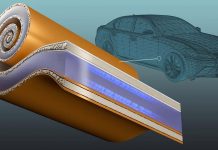A new study has shown that a great potential improvement could be done to expand the use of silicon in batteries.
It could extend the life of Li-ion batteries as much as five times.
The study was conducted by researchers from Drexel University and Trinity College in Ireland.
Previously, scientists have found that the newest lithium-ion batteries could extend the charge-to-charge life by up to 40%.
This is happening because developers are replacing the battery’s graphite anode with one made from silicon.
The current study shows if the silicon is fortified with a special type of material called MXene, the improvement can be bigger.
The improvement is possible because the MXene material could prevent the silicon anode from expanding to its breaking point during charging.
In the present study, the researchers mixed silicon powder into a MXene solution to develop a hybrid silicon-MXene anode.
MXenes were first discovered at Drexel in 2011.
They were made by a layered ceramic material called a MAX phase. Researchers removed a set of chemically-related layers, leaving a stack of two-dimensional flakes.
So far researchers have produced more than 30 types of MXene.
The team in the study found adding MXene materials to the silicon anodes could help stabilize them be used in batteries.
According to the researchers, MXenes are the key to helping silicon reach their potential in batteries.
This is because MXenes are 2D materials, and there is more room for the ions in the anode.
Ions could move more quickly into the material and thus improve capacity and conductivity of the electrode. The mechanical strength is also much better.
The results suggest that the continuous network of MXene nanosheets could provide sufficient electrical conductivity and free space for volume change.
The finding could also resolve the mechanical instability of Si. Combination of MXene ink and high-capacity Si may help construct high-level nanostructures.
One study co-author is Yury Gogotsi, Ph.D., Distinguished University and Bach Professor. The lead author is Chuanfang Zhang, a post-doctoral researcher at Trinity College.
The research is published in Nature Communications.
Copyright © 2019 Knowridge Science Report. All rights reserved.
Further reading: Nature Communications.



